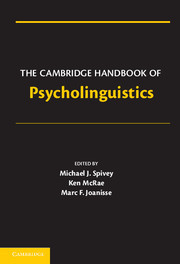Part I. Speech Perception: 1. Speech perception Carol A. Fowler and James S. Magnuson; 2. Neural bases of speech perception – phonology, streams and auditory word forms Sophie Scott; 3. Learning the sounds of language Jenny R. Saffran and Sarah D. Sahni; Part II. Spoken Word Recognition: 4. Current directions in research in spoken word recognition Arthur G. Samuel and Meghan Sumner; 5. Computational models of spoken word recognition James S. Magnuson, Daniel Mirman and Harlan D. Harris; 6. Finding the words: how young children develop skill in interpreting spoken language Anne Fernald and Michael Frank; 7. Event-related potentials and magnetic fields associated with components and subcomponents that enable spoken word recognition John F. Connolly, Randy L. Newman and Kelly Forbes; Part III. Written Word Recognition: 8. Visual word recognition in skilled adult readers Michael J. Cortese and David A. Balota; 9. Computational models of reading: connectionist and dual-route approaches Mark S. Seidenberg; 10. Decoding, orthographic learning and the development of visual word recognition Kate Nation; 11. How does the brain read words? Rebecca Sandak, Stephen J. Frost, Jay G. Rueckl, Nicole Landi, W. Einar Mencl, Leonard Katz and Kenneth R. Pugh; Part IV. Semantic Memory: 12. The human conceptual system Lawrence W. Barsalou; 13. Computational models of semantic memory George S. Cree and Blair C. Armstrong; 14. Developing categories and concepts Linda B. Smith and Eliana Colunga; Part V. Morphological Processing: 15. Derivational morphology and skilled reading: an empirical overview Kevin Diependaele, Jonathan Grainger and Dominiek Sandra; 16. The neural basis of morphology: a tale of two mechanisms? Anna Woollams and Karalyn Patterson; Part VI. Sentence Comprehension: 17. Individual differences in sentence processing Thomas A. Farmer, Jennifer B. Misyak and Morten H. Christiansen; 18. The neurobiology of sentence comprehension Lee Osterhout, Albert Kim and Gina R. Kuperberg; 19. Computational and corpus models of human sentence comprehension Douglas Roland and Mary Hare; Part VII. Sentence Production: 20. Research in language production Zenzi M. Griffin and Christopher M. Crew; 21. Language production: computational models Gary S. Dell and Joana Cholin; 22. Language production: patient and imaging research Gabriella Vigliocco, Daniel Tranel and Judit Druks; Part VIII. Figurative Language: 23. Figurative language: normal adult cognitive research Raymond W. Gibbs, Jr, Nicole L. Wilson and Gregory A. Bryant; 24. Computational approaches to figurative language Birte Loenneker-Rodman and Srini Narayanan; 25. The development of figurative language Cristina Cacciari and Roberto Padovani; 26. Cognitive neuroscience of figurative language Seana Coulson; Part IX. Discourse and Conversation: 27. Spoken discourse and its emergence Herbert H. Clark; 28. Computational modeling of discourse and conversation Arthur C. Graesser, Danielle S. Macnamara and Vasile Rus; 29. Children, conversation, and acquisition Eve Clark; 30. The electrophysiology of discourse and conversation Jos J. A. Van Berkum; Part X. Language and Thought: 31. How the languages we speak shape the ways we think: the FAQs Lera Boroditsky; 32. Computational approaches to language and thought Terry Regier; 33. Language and cognition in development Dedre Gentner and Stella Christie; 34. Language, thought and … brain? Monica Gonzalez-Marquez.




